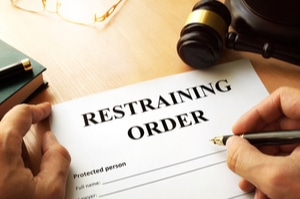How Long Does a Domestic Violence Restraining Order Last?
 In domestic abuse cases, the State of California permits victims to seek protection through protective orders like restraining orders. A domestic violence restraining order is a protective order that requires the alleged abuser to stay a minimum distance away from the person who requested the order. Restraining orders not only require alleged domestic abusers to maintain physical distance from their victims, but they may also carry a long list of restrictions that can become a significant inconvenience to your life.
In domestic abuse cases, the State of California permits victims to seek protection through protective orders like restraining orders. A domestic violence restraining order is a protective order that requires the alleged abuser to stay a minimum distance away from the person who requested the order. Restraining orders not only require alleged domestic abusers to maintain physical distance from their victims, but they may also carry a long list of restrictions that can become a significant inconvenience to your life.
If you’ve been served with the documentation for a restraining order, you must follow the terms closely. Domestic violence restraining orders may make it so that you cannot contact the petitioner, share their home, or see your children if you have any with the person who filed the order against you. Naturally, you might be wondering how long the ordeal will last. It all depends on the type of order the court issued.
Who Can Seek a Domestic Violence Restraining Order in California?
Domestic violence victims may seek restraining orders to protect themselves against abuse from people they have a close relationship with. In a domestic violence situation, this may include a spouse, dating partner, former spouse, a partner you’re separated from, a person you’re living with, someone you share a child with, or someone you’re closely related to, such as a parent, child, sibling, grandparent, or in-law. These orders require the respondent (the person served with the order) to abide by specific rules for the duration of the order.
What Restrictions Can a Restraining Order Impose?
A restraining order generally works to keep an abuser out of the life of their victim. If you have a restraining order against you, you may not legally contact the person who filed the order, their children, other relatives, or others who live with you. Additionally, you may not:
- Go near the victim’s house, place of employment, or their children’s schools
- Live with the victim. If you live together, you will need to move out.
- Own or possess a gun
- Skip child support or spousal or partner support payments
- Interact with the victim’s pets
- Skip paying bills
- Make changes to insurance policies
- Incur large expenses if you are married to the victim
The order can also require you to do certain things, like return the victim’s property and attend a 52-week batterer intervention program.
Types of Domestic Violence Restraining Orders
Three main types of domestic violence restraining orders protect victims in California. These are emergency protective orders, temporary restraining orders, and permanent restraining orders.
Emergency Protective Orders
Emergency protective orders are a special type of restraining order that only a police officer can request from the court. Police officers may request EPOs at any time of day or night, as judges are on-call 24/7 to grant them. Officers responding to domestic violence incidents may request them to get immediate protection for victims
Emergency protective orders start immediately and may last a week. The judge may order the abusive person to leave their home and stay away from the victim and their children. This gives victims enough time to request a temporary restraining order from the court, which lasts longer than one week but less than one month.
Temporary Restraining Orders
California courts grant temporary restraining orders (TROs) to domestic violence victims when they go to court to request them themselves. Victims complete paperwork that explains the series of events that brought them to apply for a restraining order. The judge must believe the story to grant a TRO that lasts between 20 and 25 days, which provides enough time to schedule a hearing. At this hearing, the respondent may formally respond to the accusations against him or her. The judge may also issue a permanent restraining order.
Permanent Restraining Orders
If a judge believes that it’s prudent to issue a permanent protective order, they may grant a permanent restraining order at the temporary restraining order hearing. Permanent restraining orders last up to 5 years. When they expire, victims may request that the court renew them to continue to receive protection.
Talk to Dod Law About Challenging a Restraining Order in California
Having a restraining order against you means losing certain rights and privileges without ever having been charged with a crime. If you’re the subject of a restraining order in California, you’re strongly urged to seek representation for your hearing. A domestic violence defense lawyer like Attorney Dod of Dod Law can help you protect your reputation. It may be possible to sway the judge against granting a permanent restraining order with a compelling argument.
Dod has practiced criminal defense for more than 17 years and has worked on more than 6,500 cases in San Diego. Find out how he can help you with a free consultation. Call 619-814-5110 or complete our contact form today.
At a Glance
Meet Attorney Dod Ghassemkhani
- Recent Case Results
- San Diego Criminal Defense Bar Association | Named San Diego County’s 2023 Trial Lawyer Of The Year
- Award Winning Criminal Defense Attorney
- The National Trial Lawyers: Top 100 Trial Lawyers
- Over 20 years of criminal defense experience
- 10.0 “Superb” Avvo Rating
